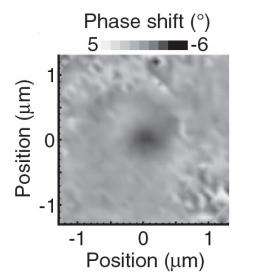September 6, 2011 feature
Single molecule can shift the phase of a laser beam

(PhysOrg.com) -- The ability to control light forms the basis of many technologies, from microscopy to optical computing. Now, a team of scientists from ETH in Zurich, Switzerland, has demonstrated that a single organic molecule can shift the phase of a laser beam by three degrees. That amount of phase shift is enough to allow the researchers to perform applications such as recording the first phase-contrast images of single molecules and fabricating a single-molecule electro-optical phase switch.
The scientists, led by Professor Vahid Sandoghdar (now at the Max Planck Institute for the Science of Light in Erlangen, Germany), have published their study in a recent issue of Physical Review Letters. The work was supported by the Swiss National Foundation and the ETH Fellows program.
To demonstrate how a molecule can change the phase of a light beam, the researchers detected organic molecules (dibenzanthanthrene) embedded in a solid matrix by performing coherent extinction spectroscopy at liquid helium temperature (near absolute zero). In this procedure, they tightly focused an excitation laser beam on the molecular sample in front of a mirror.
Next, the researchers arranged an interferometer consisting of two laser beams traveling the same path but with a small (115 MHz) frequency offset. As the laser frequencies traveled through the resonance of a single molecule, the researchers observed that the phase of one of the two interferometer beams was shifted by three degrees.
Controlling the phase of light could have a wide variety of applications, such as recording phase-contrast images of single molecules. In this study, the researchers showed for the first time how to produce a phase-contrast image of a molecule in two dimensions, which they achieved by scanning a laser beam across the molecule. In phase-contrast imaging, different structures in a sample refract light differently so that some light waves are out of phase with others. The phase difference results in some areas appearing darker or brighter than others, and makes it possible to distinguish between structures of similar transparency. The researchers predict that, by extending the method to three dimensions, they could also record a three-dimensional holographic image of an individual molecule.
The researchers also demonstrated that the ability to control the phase shift of a light beam with a molecule could serve as a single-molecule electro-optical phase switch by applying a voltage to the microelectrodes embedded in the sample. Further extension of the results could also allow for all-optical phase switching at the single-photon level. Other applications could include fast optical coherent signal processing and quantum gate operations.
More information: M. Pototschnig, et al. “Controlling the Phase of a Light Beam with a Single Molecule.” Physical Review Letters 107, 063001 (2011) DOI:10.1103/PhysRevLett.107.063001
Copyright 2011 PhysOrg.com.
All rights reserved. This material may not be published, broadcast, rewritten or redistributed in whole or part without the express written permission of PhysOrg.com.


















